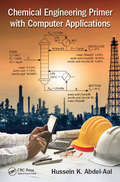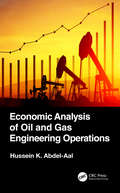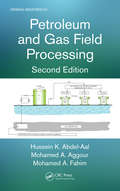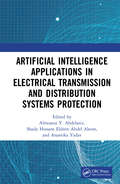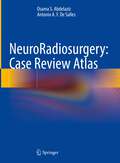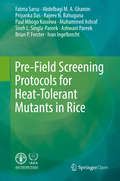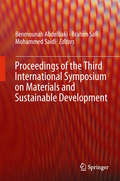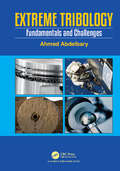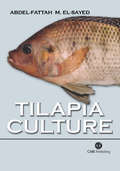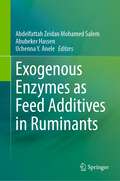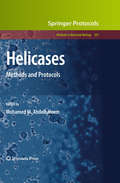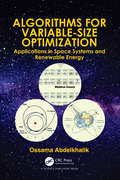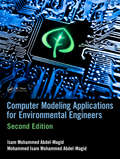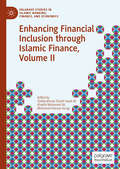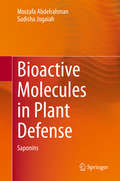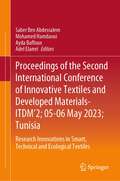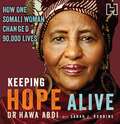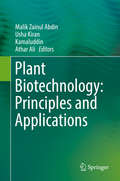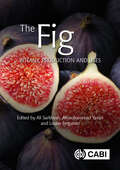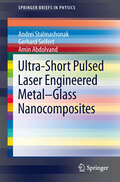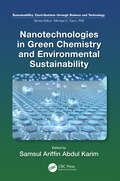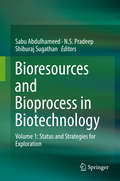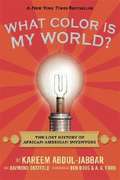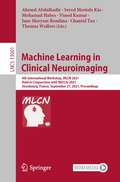- Table View
- List View
Chemical Engineering Primer with Computer Applications
by Hussein K. Abdel-AalTaking a highly pragmatic approach to presenting the principles and applications of chemical engineering, this companion text for students and working professionals offers an easily accessible guide to solving problems using computers. The primer covers the core concepts of chemical engineering, from conservation laws all the way up to chemical kinetics, without heavy stress on theory and is designed to accompany traditional larger core texts. The book presents the basic principles and techniques of chemical engineering processes and helps readers identify typical problems and how to solve them. Focus is on the use of systematic algorithms that employ numerical methods to solve different chemical engineering problems by describing and transforming the information. Problems are assigned for each chapter, ranging from simple to difficult, allowing readers to gradually build their skills and tackle a broad range of problems. MATLAB and Excel® are used to solve many examples and the more than 70 real examples throughout the book include computer or hand solutions, or in many cases both. The book also includes a variety of case studies to illustrate the concepts and a downloadable file containing fully worked solutions to the book’s problems on the publisher’s website. Introduces the reader to chemical engineering computation without the distractions caused by the contents found in many texts. Provides the principles underlying all of the major processes a chemical engineer may encounter as well as offers insight into their analysis, which is essential for design calculations. Shows how to solve chemical engineering problems using computers that require numerical methods using standard algorithms, such as MATLAB® and Excel®. Contains selective solved examples of many problems within the chemical process industry to demonstrate how to solve them using the techniques presented in the text. Includes a variety of case studies to illustrate the concepts and a downloadable file containing fully worked solutions to problems on the publisher’s website. Offers non-chemical engineers who are expected to work with chemical engineers on projects, scale-ups and process evaluations a solid understanding of basic concepts of chemical engineering analysis, design, and calculations.
Economic Analysis of Oil and Gas Engineering Operations
by Hussein K. Abdel-AalEngineers seek solutions to problems, and the economic viability of each potential solution is normally considered along with the technical merits. This is typically true for the petroleum sector, which includes the global processes of exploration, production, refining, and transportation. Decisions on an investment in any oil or gas field development are made on the basis of its value, which is judged by a combination of a number of economic indicators. Economic Analysis of Oil and Gas Engineering Operations focuses on economic treatment of petroleum engineering operations and serves as a helpful resource for making practical and profitable decisions in oil and gas field development. Reflects major changes over the past decade or so in the oil and gas industry Provides thorough coverage of the use of economic analysis techniques in decision-making in petroleum-related projects Features real-world cases and applications of economic analysis of various engineering problems encountered in petroleum operations Includes principles applicable to other engineering disciplines This work will be of value to practicing engineers and industry professionals, managers, and executives working in the petroleum industry who have the responsibility of planning and decision-making, as well as advanced students in petroleum and chemical engineering studying engineering economics, petroleum economics and policy, project evaluation, and plant design.
Petroleum and Gas Field Processing (ISSN)
by Hussein K. Abdel-Aal Mohamed A. Aggour Mohamed A. FahimMany oil production processes present a significant challenge to the oil and gas field processing facilities and equipment design. The optimization of the sequential operations of handling the oil–gas mixture can be a major factor in increasing oil and gas production rates and reducing operating costs.Petroleum and Gas Field Processing provides an all-inclusive guide to surface petroleum operations and solves these and other problems encountered in the field processing of oil and gas. Fully revised and updated to reflect major changes over the past decade or so, this second edition builds on the success attained in the first edition. It delivers an expanded and updated treatment that covers the principles and procedures related to the processing of reservoir fluids for the separation, handling, treatment, and production of quality petroleum oil and gas products.With five new chapters, this second edition covers additional subjects, in particular natural gas, economics and profitability, oil field chemicals, and piping and pumps. The book also contains worked-out examples and case studies from a variety of oil field operations.
Artificial Intelligence Applications in Electrical Transmission and Distribution Systems Protection
by Almoataz Y. AbdelazizArtificial intelligence (AI) can successfully help in solving real-world problems in power transmission and distribution systems because AI-based schemes are fast, adaptive, and robust and are applicable without any knowledge of the system parameters. This book considers the application of AI methods for the protection of different types and topologies of transmission and distribution lines. It explains the latest pattern-recognition-based methods as applicable to detection, classification, and location of a fault in the transmission and distribution lines, and to manage smart power systems including all the pertinent aspects. FEATURES Provides essential insight on uses of different AI techniques for pattern recognition, classification, prediction, and estimation, exclusive to power system protection issues Presents an introduction to enhanced electricity system analysis using decision-making tools Covers AI applications in different protective relaying functions Discusses issues and challenges in the protection of transmission and distribution systems Includes a dedicated chapter on case studies and applications This book is aimed at graduate students, researchers, and professionals in electrical power system protection, stability, and smart grids.
NeuroRadiosurgery: Case Review Atlas
by Osama S. Abdelaziz Antonio A.F. De SallesThis book is one-of-a-kind comprehensive Radiosurgery Case Review Atlas that includes not only cranial and spinal cases, but also structural and functional radiosurgery ones. It categorizes the various radiosurgery-treated pathologies, presenting illustrative case reviews for each category. Each case includes a clinical summary, a treatment protocol, a radiosurgery dosimetry summary, the pre-radiosurgery images and the serial, short-term and long-term, follow up images illustrating the clinical and radiologic outcomes of the radiosurgery treatment. Offering the readers a handy step-by-step practical guide to perform safe and effective radiosurgery treatment, this will be a useful toolkit for neurosurgeons, radiation neuro-oncologists and radiation physicists (Radiosurgeons) conducting radiosurgery programs or involved in radiosurgery training.
Pre-Field Screening Protocols for Heat-Tolerant Mutants in Rice
by Abdelbagi M.A. Ghanim Ivan Ingelbrecht Brian P. Forster Ashwani Pareek Sneh L. Singla-Pareek Muhammed Ashraf Paul Mbogo Kusolwa Rajeev N. Bahuguna Priyanka Das Fatma SarsuThis open access book presents simple, robust pre-field screening protocols that allow plant breeders to screen for enhanced tolerance to heat stress in rice. Two critical heat-sensitive stages in the lifecycle of the rice crop are targeted – the seedling and flowering stages – with screening based on simple phenotypic responses. The protocols are based on the use of a hydroponics system and/or pot experiments in a glasshouse in combination with a controlled growth chamber where the heat stress treatment is applied. The protocols are designed to be effective, simple, reproducible and user-friendly. The protocols will enable plant breeders to effectively reduce the number of plants from a few thousands to less than 100 candidate individual mutants or lines in a greenhouse/growth chamber, which can then be used for further testing and validation in the field conditions. The methods can also be used to classify rice genotypes according to their heat tolerance characteristics. Thus, different types of heat stress tolerance mechanisms can be identified, presenting opportunities for pyramiding different (mutant) sources of heat stress tolerance.
Proceedings of the Third International Symposium on Materials and Sustainable Development
by Benmounah Abdelbaki Brahim Safi Mohammed SaidiThe third International Symposium on Materials and Sustainable Development ISMSD2017 (CIMDD2017) will include a 2-day Conferences (07 & 08 November). Organized by the Research Unit: Materials, Processes and Environment and University M'hamed Bougara of Boumerdes, this symposium follows the success of CIMDD 2013-2015 and continues the traditions of the highly successful series of International Conferences on the materials, processes and Environment. The Symposium will provide a unique topical forum to share the latest results of the materials and sustainable development research in Algeria and worldwide.
Extreme Tribology: Fundamentals and Challenges
by Ahmed AbdelbaryTribology is an unfamiliar term for many, but is experienced by all. It is the science of friction, wear and lubrication of contacting surfaces in relative motion. The aim of this book is to introduce the fundamentals of tribology as well as its challenges in extreme operating conditions. The book comprises a historical background and an introduction to familiarize both undergraduate and postgraduate readers with such an important topic. It addresses a comprehensive coverage of classical tribology of solid contacts, friction mechanics, wear mechanisms and lubrication technologies. The tribology of polymer composites, MEMS and NEMS are explored. In addition, tribology of automotive components is presented, as are tribological applications in many practical situations.Various test methods used in evaluating wear are reviewed. Diverse techniques applied in predicting wear behavior by mathematical models, FE modeling and ANN approach are discussed. The book reviews key features of extraordinary conditions associated with, but not limited to, harsh environments, severe sliding and poor lubrication challenges. A basic understanding of failure modes in tribological systems is covered. The state-of-the-art research on tribology under these extreme conditions is extensively discussed, which will be of interest to researchers. The book highlights solutions for extreme tribology problems and provides an overview of various factors affecting tribosystems in harsh conditions.
Tilapia Culture
by Abdel-Fattah M. El-SayedTilapia culture is currently practiced in 95 countries all over the world and the number is expected to increase. This book discusses in detail the principles and practices of tilapia culture in the world. It covers all the vital issues of farmed tilapia including: the biology, environmental requirements, semi-intensive culture, intensive culture systems, feed and feeding, reproduction and breeding, spawning and larval rearing, stress and diseases, harvesting and marketing and the role of tilapia culture in rural development. It also highlights and presents the experiences of leading countries in tilapia culture.
Exogenous Enzymes as Feed Additives in Ruminants
by Abdelfattah Zeidan Mohamed Salem Abubeker Hassen Uchenna Y. AneleThis book addresses a global issue of increasing high quality food from ruminant animals while reducing their impacts on the environment. However, one of the main constraints to livestock development and the underlying cause of the low productivity in many developing countries is inadequate nutrition associated with inefficient utilization of forages and fibrous feed resources. In many countries, fibrous feed makes up the bulk of available feed resource base, which is characterized by scarcity and fluctuating supply in the quantity and quality of feed resources, nutrient imbalance as seen in many native pastures, grasslands and crop residues-based feeding systems with limited use of commercial concentrate feeds such as soybean, cottonseed and groundnut meals, etc. Furthermore, the production of methane, an important greenhouse gas (GHG), from ruminants fed highly fibrous diets such as straws and stover is higher than those animals fed better quality forages or concentrate diets. Recent research shows that supplementing livestock diets with exogenous fibre degrading enzymes can improve feed utilization by enhancing intake, fibre degradation in the rumen and overall digestibility of fibrous feeds which in turn leads to improved animal performance, farmers’ income, and a reduction in GHG emissions. The book editors would like to acknowledge the Joint FAO/IAEA Division of Nuclear Techniques in Food and Agriculture for funding part of the studies that make up some of these chapters and were part of the final reports of a coordinated research project financed by IAEA.
Effluent Dye Removal by Microwave-Assisted Activated Carbon (SpringerBriefs in Molecular Science)
by Rehab AbdelghaffarThis book explores the potential of advanced microwave techniques, specifically microwave-assisted pyrolysis, for the production, adsorption, and regeneration of activated carbon (AC) as a promising solution to address wastewater pollution caused by dyes. The author begins with a chapter devoted to the environmental implications of water pollution and emphasizes the characteristics of dyes and various treatment techniques for their removal. The advantages and disadvantages of commercially available activated carbon are also discussed, along with the determinants for effective adsorption using high-quality activated carbon. Additionally, the chapter delves into the different types of adsorbents, including agricultural and industrial waste, as well as bioadsorbents such as microorganisms. In Chapter 2, readers will find the latest trends in using microwave techniques for the activation process. In this chapter, the author elucidates the characteristics and mechanism of microwave heating and compares it with conventional heating methods. The advantages of microwave techniques, such as improved activation procedures and the influence of different factors, are explored. Various modeling and optimization approaches for adsorption and different techniques for analyzing the surface chemistry of activated carbons are also discussed. Furthermore, the chapter showcases the applications of microwave-assisted activated carbon for dye removal. The book closes with a chapter devoted to the recycling and regeneration of spent activated carbon (SAC) using microwave techniques. In this chapter, the author examines the procedures for SAC regeneration through microwave-assisted pyrolysis and highlights the advantages over conventional heating methods. The applications of microwave-assisted activated carbon regeneration and other miscellaneous technologies utilizing microwave heating for AC production and SAC regeneration are also explored. Given its breadth, this book is a valuable resource for researchers, professionals, and policymakers in the field of environmental science and engineering.
Helicases
by Mohamed M. AbdelhaleemIn recent years, much information has been revealed concerning the essential role of helicases, the enzymes that utilize the energy derived from nucleoside triphosphate hydrolysis to unwind the double stranded helical structure of nucleic acids. In Helicases: Methods and Protocols, this topic is explored by leading international scientists who have contributed significantly to our current understanding of helicases and the ways in which they function. Chapters include methods for the production and purification of helicases from different species, as well as detailed studies of helicase activities, including NTP binding and hydrolysis, nucleic acid binding and unwinding, and translocation along nucleic acid substrates. Composed in the highly successful Methods in Molecular BiologyTM series format, each chapter contains a brief introduction, step-by-step methods, a list of necessary materials, and a Notes section which shares tips on troubleshooting and avoiding known pitfalls. Wide-ranging and innovative, Helicases: Methods and Protocols is the ultimate guide for researchers, providing the scientific community with comprehensive accounts of the most advanced methods used to study helicases today.
Algorithms for Variable-Size Optimization: Applications in Space Systems and Renewable Energy
by Ossama AbdelkhalikMany systems architecture optimization problems are characterized by a variable number of optimization variables. Many classical optimization algorithms are not suitable for such problems. The book presents recently developed optimization concepts that are designed to solve such problems. These new concepts are implemented using genetic algorithms and differential evolution. The examples and applications presented show the effectiveness of the use of these new algorithms in optimizing systems architectures. The book focuses on systems architecture optimization. It covers new algorithms and its applications, besides reviewing fundamental mathematical concepts and classical optimization methods. It also provides detailed modeling of sample engineering problems. The book is suitable for graduate engineering students and engineers. The second part of the book includes numerical examples on classical optimization algorithms, which are useful for undergraduate engineering students. While focusing on the algorithms and their implementation, the applications in this book cover the space trajectory optimization problem, the optimization of earth orbiting satellites orbits, and the optimization of the wave energy converter dynamic system: architecture and control. These applications are illustrated in the starting of the book, and are used as case studies in later chapters for the optimization methods presented in the book.
Computer Modeling Applications for Environmental Engineers
by Isam Mohammed Abdel-Magid Ahmed Mohammed Isam Mohammed Abdel-MagidComputer Modeling Applications for Environmental Engineers in its second edition incorporates changes and introduces new concepts using Visual Basic.NET, a programming language chosen for its ease of comprehensive usage. This book offers a complete understanding of the basic principles of environmental engineering and integrates new sections that address Noise Pollution and Abatement and municipal solid-waste problem solving, financing of waste facilities, and the engineering of treatment methods that address sanitary landfill, biochemical processes, and combustion and energy recovery. Its practical approach serves to aid in the teaching of environmental engineering unit operations and processes design and demonstrates effective problem-solving practices that facilitate self-teaching. A vital reference for students and professional sanitary and environmental engineers this work also serves as a stand-alone problem-solving text with well-defined, real-work examples and explanations.
Enhancing Financial Inclusion through Islamic Finance, Volume II (Palgrave Studies in Islamic Banking, Finance, and Economics)
by Abdelrahman Elzahi Saaid Ali Khalifa Mohamed Ali Mohamed Hassan AzragThis book is the second of two volumes which highlight the concept of financial inclusion from the Islamic perspective. An important element of the Sustainable Development Goals (SDGs), financial inclusion has been given significant prominence in reform and development agendas proposed by the United Nations and G-20. The significance of Islamic financial inclusion goes beyond improved access to finance to encompass enhanced access to savings and risk mitigation products, as well as social inclusion that allows individuals and companies to engage more actively in the real economy. It represents one of the important drivers of economic growth. This volume explores the financial risks associated with lending to low-income groups due to high poverty levels and the lack of collateralization mechanisms. The first book on the market to provide empirical evidence of Islamic microfinance, deposit insurance and micro-entrepreneurship through the analysis of models and country case studies, this edited collection will be of value to those researching development finance, financial inclusion and Islamic finance.
Bioactive Molecules in Plant Defense: Saponins
by Mostafa Abdelrahman Sudisha JogaiahThis book presents a broad perspective on saponins as important natural products with a key role in plant defense. The presence of saponins has been reported in several plant species, and many types of saponins have been found to exhibit significant antifungal activities. In addition to their role in plant defense, saponins are of increasing interest for drug research, as they are active ingredients in several traditional medicines and hold potentially valuable pharmacological properties. In this book, the authors briefly introduce readers to saponin accumulation in various plant organs, with a specific focus on their structure classification and diversity. Readers will find detailed information on the saponin structure-activity relationship and saponins’ vital role in sustainable agriculture as a chemical barrier to pathogen attack. The latest techniques for isolating, identifying, and quantifying saponins are also discussed. In the closing chapter, the authors outline the recent metabolic engineering strategies applied to improve saponin glycosides production and their potential applications in plant disease resistance.This book and the companion volume Bioactive Molecules in Plant Defense: Signaling in Growth and Stress offer vital resources for all researchers and students interested in plant pathology, mycology and sustainable agriculture.
Proceedings of the Second International Conference of Innovative Textiles and Developed Materials-ITDM’2; 05-06 May 2023; Tunisia: Research Innovations in Smart, Technical and Ecological Textiles
by Saber Ben Abdessalem Mohamed Hamdaoui Ayda Baffoun Adel ElamriThis book includes selected articles from the 2nd International Conference on Innovative Textiles and Developed Materials (ITDM’2) held in Monastir, Tunisia, on May 5 and 6, 2023. The articles present latest scientific concepts and technological advances in innovative and sustainable textile materials and processes worldwide. The conference promotes exchange of ideas and emerging technologies to foster collaboration between academia and industry.
Keeping Hope Alive: How One Somali Woman Changed 90,000 Lives
by Dr. Hawa AbdiFor the last twenty years, Dr Hawa Abdi and her daughters have run a refugee camp on their family farm not far from Mogadishu which has grown to shelter 90,000 displaced Somalis: men, women, and children in urgent need of medical attention. As Islamist militia groups have been battling for control of the country creating one of the most dire human rights crises in the world, Dr. Abdi's camp is a beacon of hope for the Somalis, most of whom have no proper access to health care. She was recently held hostage by a militant groups who threatened her life and told her that because she's a woman she has no right to run the camp. She refused to leave.This is not just the story of a woman doctor in a war torn Islamic country risking her life daily to minister to thousands of desperate people, it's also an inspiring story of a divorced woman and her two daughters, bound together on a mission to rehabilitate a country.
Plant Biotechnology: Principles and Applications
by Malik Zainul Abdin Usha Kiran Kamaluddin Athar AliThe book traces the roots of plant biotechnology from the basic sciences to current applications in the biological and agricultural sciences, industry, and medicine. Providing intriguing opportunities to manipulate plant genetic and metabolic systems, plant biotechnology has now become an exciting area of research. The book vividly describes the processes and methods used to genetically engineer plants for agricultural, environmental and industrial purposes, while also discussing related bioethical and biosafety issues. It also highlights important factors that are often overlooked by methodologies used to develop plants' tolerance against biotic and abiotic stresses and in the development of special foods, bio-chemicals, and pharmaceuticals. The topics discussed will be of considerable interest to both graduate and postgraduate students. Further, the book offers an ideal reference guide for teachers and researcher alike, bridging the gap between fundamental and advanced approaches.
The Fig: Botany, Production and Uses (Botany, Production and Uses)
by Mohammad Abdolahipour Fateh Aljane Azam Amiri Maria L Amodio Francisco C Balas Patrick Brown Zeinab Bolboli Anshul Chawla Pasqualina Colasuonno Giancarlo Colelli Neda Dalir Naser Davatgar Birgül Ertan Engin Ertan Louise Ferguson Giuseppe Ferrara Badii Gaaliche Ana I Galván A. J Galán Carlos A. Garza Jan H. Giliomee Phoebe Gordon Matthew J. Grieshop G Dalkiliç Günver Professor Jose Ignacio Hormaza Akihiro Hosomi Hidetoshi Ikegami Ali Akbar Kamgar-Haghighi Finn Kjellberg Moslem Jafari Zhihong Li Margarita López Corrales Mahshad Maghoumi Giuseppe Massimino Cocuzza Chabane Mazri Andrea Mazzeo Themis J. Michailides Reza Mostowfizadeh-Ghalamfarsa Diganta Narzary Mohamed H Neily Hitoshi Nogata Professor A Aytekin Polat Asghar Ramezanian Jean-Yves Rasplus Maria G.F. Rodrigues Sead Sabanadzovic Rajwinder K. Sandhu Manuel Joaquín Serradilla Sánchez Zeinab Shokoohi Federica Spagnoli Vassilio Stournaras Mohammad H. Tarazkar Dr Ioannis Tzanetakis Simon Van Noort Alimohammad Yavari Hiroshi Yakushiji Yue Zhang Megan Crivelli Tatjana K Kokaj Souhila Mahmoudi Ilaria MarcotuliThe common fig Ficus carica L. is an ancient fruit native to the Mediterranean. Dried figs have been successfully produced and processed in arid regions with little sophisticated infrastructure for centuries. Figs are rich in fibre, trace minerals, polyphenols and vitamins, with higher nutrient levels than most fruits. Advances in agricultural production and postharvest technologies have not only improved the efficiency of dried fig production but have facilitated the development of high value fresh fig industries both for export and domestic markets. The result is high quality fresh figs that are marketed internationally throughout the year. This book provides a comprehensive summary of fig growing, processing and marketing from a scientific and horticultural perspective. It is comprised of 19 chapters that include in-depth discussions of: History of fig cultivation; Physiology; Breeding and cultivars; Propagation; Site selection and orchard establishment; Nutrition and irrigation management; Pollination management; Integrated pest management; Greenhouse production; Harvesting, dried and fresh fig processing; The medicinal uses of figs; and World fig markets. The Fig: Botany, Production and Uses is a comprehensive applied resource for academic researchers, as well as producers, processors, and marketers of dried and fresh figs.
Ultra-Short Pulsed Laser Engineered Metal-Glass Nanocomposites
by Amin Abdolvand Andrei Stalmashonak Gerhard SeifertGlasses containing metallic nanoparticles exhibit very promising linear and nonlinear optical properties, mainly due to the surface plasmon resonances (SPRs) of the nanoparticles. The spectral position in the visible and near-infrared range and polarization dependence of the SPR are characteristically determined by the nanoparticles' shapes. The focus of Ultra-Short Pulsed Laser Engineered Metal-Glass Nanocomposites is the interaction of intense ultra-short laser pulses with glass containing silver nanoparticles embedded in soda-lime glass, and nanostructural modifications in metal-glass nanocomposites induced by such laser pulses. In order to provide a comprehensive physical picture of the processes leading to laser-induced persistent shape transformation of the nanoparticles, series of experimental results investigating the dependences of laser assisted shape modifications of nanoparticles with laser pulse intensity, excitation wavelength, temperature are considered. In addition, the resulting local optical dichroism allows producing very flexibly polarizing optical (sub-) microstructures with well-specified optical properties. The achieved considerable progress towards technological application of this technique, in particular also for long-term optical data storage, is also discussed.
Nanotechnologies in Green Chemistry and Environmental Sustainability (Sustainability: Contributions through Science and Technology)
by Abdul Karim, Samsul AriffinNanotechnologies represent a fast-growing market and this unique volume highlights the current studies in applied sciences on sustainability of green science and technology. The chapters include modelling, machine learning, nanotechnology, nanofluids, nanosystems, smart materials and applications and solar and fuel cells technology. The authors cover simulation, additive manufacturing, machine learning and the autonomous system. Various aspects of green science as well as trans-disciplinary topics between fundamental science and engineering are presented.The book is suitable for all postgraduates and researchers working in this rapid growing research area. Features Presenting latest research on green materials and sustainability. Provide in depth discussion on modeling and simulation using latest techniques. Technical exposure for the readers on additive manufacturing principles. Numerous examples on nanofluids and nano technology are presented. Discusses computer modeling, superconductivity, nanotubes and related structures such as graphene.
Bioresources and Bioprocess in Biotechnology
by Sabu Abdulhameed N. S. Pradeep Shiburaj SugathanThis book is a compilation of articles on various aspects of bioresources and the processes employed for its judicious utilization. Biodiversity and conservation, food security, gene banks and repositories, laws governing biodiversity, bioprospecting, bioresources in traditional medicine and biodiversity mining are some of the important topics covered in the book. The unique contents of the book make it an important source of information for conservation scientists, academics, activists and to those who are actively involved in product oriented research from bioresources.
What Color is my World: The Lost History of African-American Inventors,
by Kareem Abdul-Jabbar Raymond ObstfeldWhile twins Ella and Herbie help the handyman Mr. Mital work on their new home, he tells them about such inventors as Granville Woods, Dr. Henry T. Sampson, and James West, giving them a new view of their heritage as African Americans.
Machine Learning in Clinical Neuroimaging: 4th International Workshop, MLCN 2021, Held in Conjunction with MICCAI 2021, Strasbourg, France, September 27, 2021, Proceedings (Lecture Notes in Computer Science #13001)
by Ahmed Abdulkadir Seyed Mostafa Kia Mohamad Habes Vinod Kumar Jane Maryam Rondina Chantal Tax Thomas WolfersThis book constitutes the refereed proceedings of the 4th International Workshop on Machine Learning in Clinical Neuroimaging, MLCN 2021, held on September 27, 2021, in conjunction with MICCAI 2021. The workshop was held virtually due to the COVID-19 pandemic. The 17 papers presented in this book were carefully reviewed and selected from 27 submissions. They were organized in topical sections named: computational anatomy and brain networks and time series.
